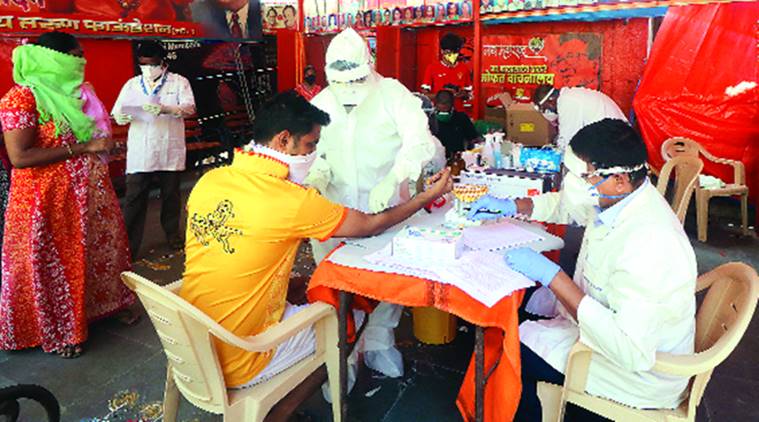 Officials collect blood samples from residents of a society in Mumbai for conducting anti-body tests. (Express Photo by Nirmal Harindran)
Officials collect blood samples from residents of a society in Mumbai for conducting anti-body tests. (Express Photo by Nirmal Harindran)
As India’s lockdown relaxes further, the ICMR has reintroduced its advice to states to use antibody tests to gauge the extent of outbreak and “guide policymakers”.
This comes a day after a new research paper published by ICMR, the country’s apex institution in biomedical research, signalled rising coronavirus positivity in patients hospitalised for severe acute respiratory illness (SARI), and has called for more population-based studies.
More than a month since the Council had revoked its advice due to faulty results, it has now suggested surveys with antibody kits — known as sero-surveys — to focus on workers who have returned home from other states, those who live in dense settings such as slums or poorly ventilated buildings like old-age homes; people who work in the press, industrial units or as labourers; vendors; the staff in municipal bodies; people in containment zones; police and paramilitary personnel, and prison officials, among others.
Calling for more population-level surveillance, the new ICMR research published on Friday indicates a rising Covid positivity rate in SARI patients. The Council has continuously stated that testing of SARI patients can help gauge the extent of the outbreak by understanding how many patients who were not known to have Covid-19 are hospitalised for severe symptoms and later found positive for the virus.
Of nearly 70,000 tests conducted on SARI patients between January 22 and April 30, the ICMR study says 4,204 people — 6.1 per cent — were reported positive for Covid-19. Unlike antibody tests, these RT-PCR tests are used for diagnosis.
This is a significant increase in confirmed coronavirus among SARI patients from previous ICMR research. From March 22 to March 28, this rate was 1.7 per cent, while it was 2.6 per cent between March 29 and April 2.
On March 22, ICMR shifted from random surveillance of SARI patients to testing all SARI patients, indicating that the jump in positivity likely came from the tests in April.
“Because the testing criteria, except for SARI, require exposure to a positive case, we are uncertain about the transmission among unlinked individuals in the community…. Implementing other methods of surveillance, such as population-based and sentinel-site-based, will help understand the trends better.” the new ICMR research states.
Uncategorised cases and tests were a large chunk of the data — 44 per cent and 56 per cent, respectively.
The new research examined more than 10 lakh tested individuals. The categories included in the analysis up until April 30 were symptomatic contacts of Covid-positive cases, symptomatic international travelers, symptomatic health care workers, hospitalised SARI patients, symptomatic people in hotspots, asymptomatic contacts of cases, and asymptomatic healthcare workers who contacted cases without adequate protection.
Since then, the testing strategy has expanded to include symptomatic returnees and migrants, hospitalised patients who then develop symptoms, and frontline workers.
SARI patients have had the second-highest positivity rate of all testing categories, second only to symptomatic contacts of positive cases (10.3), according to the paper.
India tested more asymptomatic people — a quarter of all tests — than symptomatic people (17 per cent of all tests). However, the number of cases of asymptomatic and symptomatic people is almost equal at 11,295 and 10,607, respectively.
Specifically, asymptomatic family contacts make up the highest number of cases (25 per cent) and tests (20 per cent), the study reports.
At the national level, the average number of contacts tested from one case was six, the study stated. The lowest contact-tracing states include Maharashtra (7.6 contacts tested from one case), Delhi (8.9), Gujarat (11.7), Madhya Pradesh (11.6), and Telangana (14.4).
“States demonstrated wide variations in contacts tested per case. It represents the robustness of contact tracing … As the staff responsible for contacts tracing varies across the country, this may also affect the quality of history taking,” the paper noted.
Seven districts (1 per cent of total districts) from the Northeast are not reporting any tests to ICMR, the research stated. Only Uttarakhand, Chhattisgarh, and the states in the Northeast have less than 50 per cent of their districts affected.
An ICMR study from April 9 states: “The WHO recommends countries to leverage the existing hospital-based SARI sites to complement the COVID-19 surveillance activities. This will further assist to monitor the intensity of COVID-19 transmission over time and geographical spread and to assess the severity of the disease in the country.”
Because antibodies generally begin to appear after a patient has recovered, the test to be used, the IgG ELISA Test, “indicates episode of SARS-CoV-2 infection in the past,” the ICMR stated. The agency had advised on April 22 against using the test when a set of kits — mostly from China — were found faulty. Since then, ICMR has developed its own antibody kit and embarked on two nationwide sero-surveys to understand coronavirus exposure in the community.